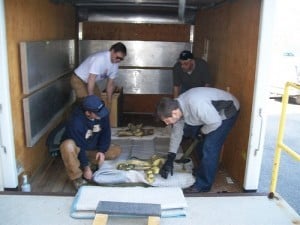Ergonomics is the process of fitting a work environment to a person. Workplaces with poor ergonomics tend to experience higher rates of musculoskeletal disorders (MSDs), placing a heavy financial burden on the company in the form of both direct and indirect costs. MSDs — conditions and/or injuries which affect the muscles, tendons and nerves — are easily prevented through proper workplace ergonomics. By adjusting the workplace to create a proper environment for workers, there are naturally fewer instances of MSD injuries.
To put the problem of MSDs into perspective, the U.S. Bureau of Labor Statistics (BLS) released a report stating that a third of all reported work injuries and illness in 2011 (387,820) were related to MSD. The report also noted that industries with the highest rates of MSD were hospitality, retail, transportation, retail, warehousing and construction. Notice something in the common with these industries? They all require moderate amounts of heavy lifting.
Lifting heavy boxes, tools or equipment improperly is poor ergonomics and can lead a wide variety of MSD injuries, including back strains and vertebrae problems. The correct way to lift an object is to plant your feet about shoulder width apart, bend your knees to lower your body, grab the object and lift it back up. Do not attempt to lift an object by bending your back, as this places unnecessary stress on the delicate cartilage supporting the vertebrae.
Common Work-Related MSD Injuries and Conditions:
- Carpal tunnel syndrome
- Tarsal tunnel syndrome
- Tendonitis
- Torn rotator cuff
- Muscle strains
- Pulled muscle
- Overexertion
Identify Problems
One of the first steps in reducing MSD injuries through workplace ergonomics is to identify ‘problem areas.’ This may include areas stations where workers are forced to bend or maneuver their bodies in awkward positions. This may not cause any immediate injury to a worker, but constantly shifting the body into awkward positions day after day will eventually take its toll, leaving the individual susceptible to MSD injury. Go through your workplace to see exactly which areas the most problematic for workers and then prioritize them accord to severity.
Anti-Fatigue Mats
You can also improve the ergonomics of your workplace by investing in anti-fatigue mats. These mats are designed to absorb the weight and pressure of workers; thus, offering a more comfortable area to stand on. Rather than forcing workers to stand on hard concrete pavement for 8 or more hours a day, they can stand on an anti-fatigue mat for a superior level of comfort.
